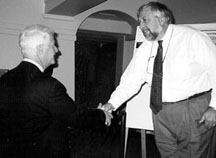 |
 |
|
 |
 |
 |
 |
 |
|
 |
 |
 |
 |

|
| |
 
Volume 11, No. 1, Spring/Winter 01 | Return to Table of Contents

The Ecosystems Center Celebrates Its 25th Anniversary
 Accompanied by spouses, children, and friends, more than 50 Ecosystems Center alumni traveled to Woods Hole in mid October to join their former colleagues for an exuberant celebration of the Center’s first 25 years. Former staff members, visiting scientists, and students came from Germany, Kenya, Sweden, and Israel as well as all parts of the U.S. to reminisce about their years at the MBL, to exchange notes on current activities, and to discuss the future of ecosystems science and its relevance to issues of public concern. Accompanied by spouses, children, and friends, more than 50 Ecosystems Center alumni traveled to Woods Hole in mid October to join their former colleagues for an exuberant celebration of the Center’s first 25 years. Former staff members, visiting scientists, and students came from Germany, Kenya, Sweden, and Israel as well as all parts of the U.S. to reminisce about their years at the MBL, to exchange notes on current activities, and to discuss the future of ecosystems science and its relevance to issues of public concern.
The festivities began the evening of October 13 with an open house in Homestead and the Environmental Sciences Laboratory. Although posters featuring current research results and plans for the Center’s new building drew their share of attention, the returnees clustered around the lists of names and medleys of photos that summoned up memories.
The lineup of speakers for the all-day symposium in Lillie Auditorium that followed on October 14 included a surprise appearance by Rep. William Delahunt of the Massachusetts 10th District, who arrived as talks were getting underway. “I wanted to say hello and congratulate you,” the congressman said in his informal remarks to the audience. “The MBL is one of the best-kept secrets in America. You are truly doing exceptional work.
“I get so envious when I hear scientists say ‘I came back to the lab after leaving Washington.’ I want to come back,” he added.
 MBL interim director William Speck welcomed symposium attendees and introduced director emeritus James Ebert, who shared his memories of the founding of The Ecosystems Center. The establishment of a center for research in the environmental sciences was a critical part of the effort, beginning in the early 1970s, to build the MBL’s endowment and to further the laboratory’s emergence as a year-round institution with goals and programs of its own, he observed. MBL interim director William Speck welcomed symposium attendees and introduced director emeritus James Ebert, who shared his memories of the founding of The Ecosystems Center. The establishment of a center for research in the environmental sciences was a critical part of the effort, beginning in the early 1970s, to build the MBL’s endowment and to further the laboratory’s emergence as a year-round institution with goals and programs of its own, he observed.
Before introducing George Woodwell, the first of the guest speakers, co-director John Hobbie gave a brief review of current modeling projects at the center. Dr. Woodwell, who founded the Center with Dr. Ebert and served as its first director, offered a personal reflection on the role of science and scientists as the “third leg of government.” Arguing that research institutions had a duty to figure out the great issues and analyze them in the public interest, he pointed to the preservation of the functional health of the earth as one of these issues.
Introducing his audience to interactions between climate patterns and changing land use in the Brazilian Amazon, Center scientist Christopher Neill noted that cleared lands and fragmented forests are more vulnerable to the drying effects of episodic El Niño conditions and thus at greater risk of fire. The drying of the Amazon, in turn, has an effect on climate patterns.
David Schimel, co-director of the Max Planck Institute of Biogeochemistry in Jena, Germany, returned to his former haunts to make a presentation on the challenge of atmospheric observations to ecosystems research. Focusing on effects at the global level, he hypothesized that variability in atmospheric carbon dioxide (CO2) levels depends primarily upon temperature changes in temperate regions and upon rainfall in the tropics. Recognition of regional variation is essential to modeling the effects of terrestrial ecosystems on global CO2 levels, he concluded.
Speakers during the afternoon session focused on the effects of human activities on the cycling of nitrogen in ecosystems.
Noting that the nitrogen cycle is the most altered by human activity of all the global element cycles, Robert Howarth of Cornell University described the effects of nitrogen pollution on coastal zones. John Aber of the University of New Hampshire reviewed the growth of the concept of nitrogen saturation in terrestrial ecosystems studies and the growing understanding of the mechanisms that affect saturation in forests and soils. Center scientist Anne Giblin drew upon her research in Boston Harbor and Massachusetts Bay to describe the sources and sinks of nitrogen in coastal waters.
Center Co-director Jerry Melillo concluded the symposium with a look to the future, describing the topics that might make up the agenda for an Ecosystems Center staff meeting in 2024. He argued that the value of long-term research, multidisciplinary approaches, vulnerability assessments, and links to policymaking would be well established by the time such a meeting took place.
The gala weekend concluded with a clambake at the Swope Center the following day for center staff members, alumni, and their families. Indian summer weather lured some of the youngest visitors into the water as their parents basked in the sun and enjoyed a final chance to catch up with each other.
Members of the organizing committee for the 25th anniversary celebration
Linda Deegan (chair)
Dixie Berthel
Sue Donovan
Hap Garritt
Pam Clapp Hinkle
John Hobbie  |
|
 |
 |
|